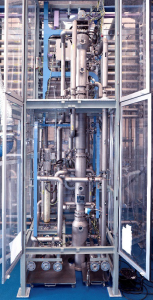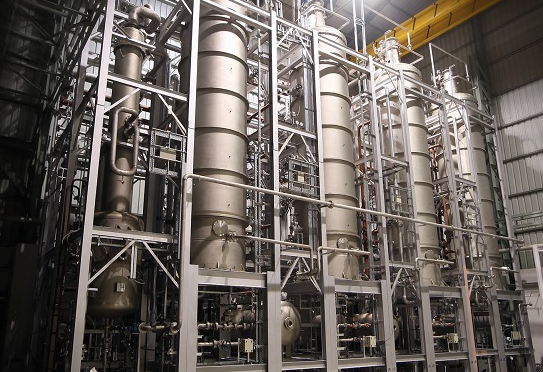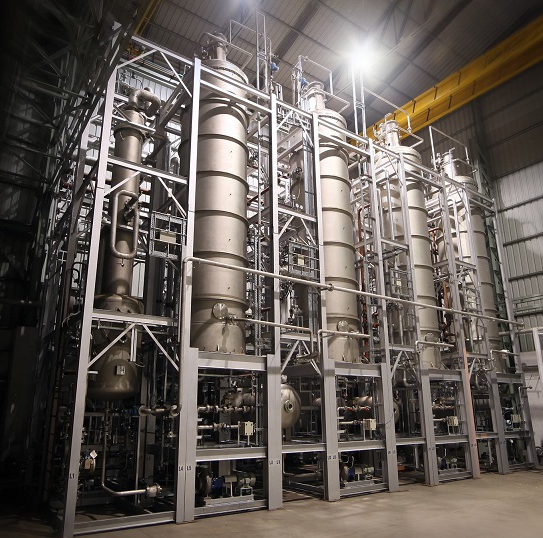It’s no secret that the digital industry is booming. From exciting startups to global brands, companies are reaching out to digital agencies, responding to the new possibilities available.
15
Aug 2022
Reactive extraction by Asymmetric Rotating Disc Contactor type Liquid-Liquid Extractor
In Pharmaceuticals industry, various reactions are done to produce API in conventional batch kettles. Based on process requirement, required reaction time is provided to complete the reaction. Once the reaction is completed, suitable solvent is used to extract API. Kettles are agitated and jacketed to provide required heating. In most cases, product extraction is followed by water washing for impurity removal. This entire process requires large number of batch reactors of higher capacities. These batch mode operations have inherent disadvantages as given below:
-
- Complete process involves lot of manual operation. This gives inconsistent product quality and batch failures.
- Increasing product capacity to manyfold has lot of challenges. This means many new batch reactors with higher capacities. This arrangement will have a huge space demand and requires lot of manpower.
- When extraction is carried out in a conventional batch kettle, fresh solvent for extraction is added several times in the same vessel. Each washing cycle would incrementally extract the desired product from the aqueous phase, producing dilute extract in each subsequent cycle. As a result, the solvent use is high and a large volume of extract leads to higher recovery costs and solvent losses.
- These issues can be overcome by converting batch process into continuous mode. For this, Technoforce make Asymmetric Rotating Disc Contactor (ARDC) type Liquid-Liquid Extractor can used for reaction followed by extraction in continuous
Figure 1 : Asymmetric Rotating Disc Contactor with cross section

ARDC is a vertical cylindrical shell having eccentric rotor. Inside ARDC has a series of mixing & settling zones created by alternating rotating and stationary baffles (see figure 1). Top and bottom of ARDC has decantation zones to decant raffinate and extract phases. The feed/solvent having higher density will be fed from top and feed/solvent with lower density will be fed from the bottom of ARDC. One of the phases will be continuous and other phase is dispersed. Both phases will be effectively mixed and settled using rotating and stationary baffles within ARDC shell. After extraction, Both the extract and raffinate will be collected in tanks after passing through settlers. ARDC will have following advantages:
-
- ARDC provides adequate mixing and residence time for the reaction to occur continuously.
- The two phases can be fed at calculated rate to give the required time for the reaction to happen.
- As the reaction required a specified temperature, both the phases can be preheated online and the extractor which is equipped with a jacked can be also kept hot by circulating hot water at the required temperature.
- ARDC require less power as compared to batch reactor.
- This efficiently designed extractor provides adequate mixing between the phases. This leads to lower feed to solvent ratios. overall requirement can get reduced by ~50 % as compared to batch extraction.
- One Liquid Liquid extractor can replace all Reactors. This leads to 70% space saving.
- No manual intervention.
- Reaction / Extraction and water washing keeps on working continuously without any involvement of manpower.
Typical Asymmetric Rotating Disc Contactor plant

Technoforce has already designed and built several ARDC type Liquid-Liquid Extractors for various industrial sectors. We also offer other evaporation technologies like Agitate Thin Film Evaporation, Short Path distillation and Drying, Falling Film, Rising Film and Forced Circulation Evaporation, as well as Centrifugal Extraction and Crystallization technologies.
Technoforce is ISO 14001:2015, ISO 45001:2018, ISO 9001:2015 certified company with decades of experience in construction under ASME U stamp and PED/CE mark certification. Technoforce also have Pilot Plants facility in The Netherland and India. Sales office in India and Germany. For more details, visit Technoforce website www.technoforce.net














![[:en]Case Study - Agitated thin film dryer: vertical[:de]Fallstudien - Aufgerührter Dünnschichttrockner - vertikal](https://www.technoforce.net/wp-content/uploads/2017/11/CS-ATFDV-Food-1-R1-672x372.png)





